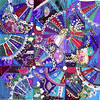Woggas and Blokes with Needles
This is just a really fast run-through, as real life is busy.
As I was fascinated to see long and thoughtful posts about Woggas/Waggas from sharonb and from Robyne. Because, although I do not want to get too hung up on definitions, I do have to say that probably my current project is not really a Wagga, but is more "A Crazy Quilt inspired by a Wagga". But I will keep referring to it as a Wogga anyway - it is more convenient.
So, why do I say it isn't a Wagga? Because to me, a Wogga is something utilitarian, produced for warmth, from resources to hand that are not usually first consideration for warmth/bedding. On mine the embroidery is equally, if not more important.
My father would have been 100 this year, were he alive, and he spent the 1930s Depression as an itinerant single man - by choice and inclination. He was a rabbit trapper, with his own plant, and had a good income. In the 1940s he bought land and became a grazier - although rabbits were still trapped for income and pest control. But he always had the Depression ethic of making do with what he could, and wasting nothing.
When my mother married him in 1948, their first quilt was what she says he definitely called his "Wheat Bag Wogga". This was just wheat bags he had sewn together, that went on top of the bed. It was heavy, and Mum found it uncomfortable, so it got short shift, and went fairly fast. Wheat sacks were very closely woven, heavy and scratchy. Sugar bags (used on others I have seen) has a much looser, lighter hessian. Despite that, I can still recall him occasionally calling anything quiltlike that you wrapped yourself in, in cold weather, a wogga.
Which got me thinking. Bag needles, as I was growing up, were my father's tool of trade, not my mother's. They were something that was in the shed. There was a time when there were men working with harvesting teams who were the bag sewing specialists, and I suspect a good bag needle (they were large and curved), were an important tool of trade for them. I don't think my father ever worked in that line, but a rabbit trapper always had several rabbit screens - long tunnels of hessian strong on poles between trees, carefully closed at the end of keep flies out. This is where they were stored until the rabbit buyer came by on his rounds, collected the rabbits and left the money for them in the screen.
The bag needle was an important tool for a rabbit trapper, both for making and for repairing rabbit screens. Sewing up wheat bags to make a cover for the bed would have been second nature for my father, who would have sewn many miles to make his screens. Both he and those who sewed up the bags of wheat and maize, used sting in the needles.
The bag needle was therefore a valued tool of trade for men, so it may not have been unusual to find men sewing with them for more than just occupational work. Did they then, at night, turn to making their own bedding in much the same way as sailors turned to re-using old ropes to make macrame, and their hammocks?
Would be fascinating to know how many Waggas were actually made by men, as opposed to women. And how sewing was viewed at that time by men.
And I would love to hear more, Ulla, about how you say these quilts were in Sweden.
Without getting too hung up on definitions - and I must see if I can find any more in collections around here.







3 Comments:
I think you're right about men weilding the sack-needles, and your Grandfther's subsequent use of the term 'Wagga' in a general, utility-blanket context, goes a long way in explaining the raw beginnings. I'm sure women used the materials at hand as much, and decided to pretty the coarse, heavy rugs up a bit, but it would be good to have a register of actual Wagga stories, like your own.
Perhaps from other countries too?
Also, I always spelt it 'Wogga' until I learned of the Wagga Wagga connection.
I think alot of the early waggas were made by men -also perhaps because there was a huge gender imbalance in OZ for a long time
on another note - we too have a rabbiter in the family
During the Depression years, more Waggas might have been made by men by necessity, as so many of them were away from their wives and families looking for that elusive work.
I know that my Father who was born in England in 1912, always told me that back then boys as well as girls were taught many sewing skills including darning.
He also told me that when serving in the British Army in WW2, he used to earn quite a bit from officers of both sexes, either sewing badges on their uniforms or mending (including the ladies stockings)
Maybe they employed him because they could well afford to, but it may well have been just the working classes that were taught these skills.
Post a Comment
<< Home